I wanted to take a fresh look at how a player’s age and level of play relate. This article will be an update to the Career Peak article.
Having written on careers and aging before, I had expectations of what I would find. I expected to find that all players eventually suffer age-related declines, that lower-rated players decline more rapidly than higher-rated players, and that higher-rated players start their age-related decline later in life. There is no reason for that to have changed.
Measuring a Player’s Effectiveness: Value Rating
I will use Value Rating (VR) to measure a player’s level of play. VR consists of a number called VR-Score (such as 6.7139) and a category based on that number (VR-First5 is the category for VR-Scores 6.0000 to 7.9999).
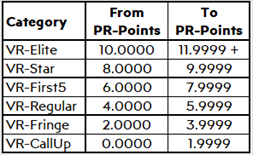
The unit of measurement for VR-Score is PR-Points, as VR is calculated from three seasons’ worth of Productivity Rating scores. PR and VR have identical category structures.
One thing you should know about Value Rating is that it works. The players who are widely regarded as the best overall in the league almost always have the highest VR scores.
How Age-to-Age Level of Play Will Be Measured
Age-to-age level of play will be measured using the VR-Score of players over two consecutive seasons. Players will be grouped based on their VR-Category and Age in one season, and their VR-Score in the next season will be used in calculations.
To qualify for analysis, a player must have a VR-Score in any season but last season, as 2024-25 does not yet have a subsequent season.
For example, in 2023-24, Eric Robinson (BUF, CBJ, F) had a VR-Score of 4.13 at the age of 28; his VR-Score in 2024-25 was 3.83.
His age and VR-Score from 2023-24 put him in the Regular 28 group. His subsequent VR-Score (3.83) will be added to the other subsequent VR-Scores of players in the Regular.28 group, and the average of those subsequent VR-Scores will be calculated and displayed on the Subsequent VR-Score by Category and Age chart.
There were 268 players in the Regular.28 group, and their average subsequent VR-Score was 4.43. 28 of the 268 players did not play their subsequent season, and a value of zero was used for their subsequent VR-Score.
Were I to do this study next year, Robinson would be in the Fringe 29 group, as his VR-Score has slipped into the VR-Fringe category.
Age by VR-Category Counts
The following table shows the count of players grouped by age and VR-Category.
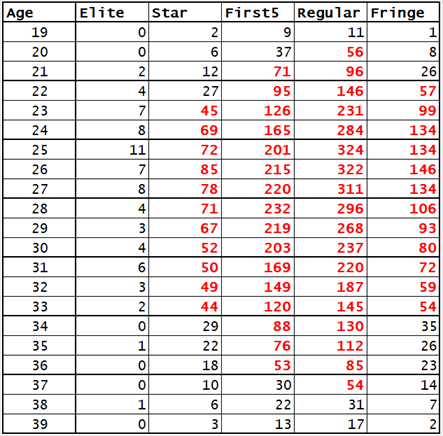
The data in this table helped in determining how many players should be in a group to use that group’s data. On looking at the data, I thought 40 would be the most appropriate number. Putting that criterion a little higher, say 50, would have resulted in the loss of three groups in the Star category.
The cells in bold-red are those whose data will be used in the chart that shows age-to-age changes in levels of play.
Note that no VR-Elite category comes close to qualifying: there just aren’t that many VR-Elite players. I was left with two options: combine VR-Elite groups across ages or combine VR-Elite and VR-Star players in one category. I decided to combine VR-Elite groups across ages.
For a specific VR-Elite age, the data that was used for calculations was one part from one year younger, two parts from the age itself and one part from one year older. Using this approach, Elite 27 had 33 players in its group (11 + 7 + 7 + 8). That figure is still below the group-size criterion of 40, but other factors led me to include them regardless. Their age-to-age data was quite consistent, it was logical with respect to VR-Star players, and it was different from VR-Stars (in that it always produced higher average future VR-Scores).
A Pointer on how to Interpret the “Subsequent VR-Score” Chart
The Subsequent VR-Score chart shows the average score of players the year after they were a certain age and held a certain VR-Score. As players progress through their careers, they can be in various VR-Categories.
The following table shows the VR-Score history of Brad Marchand, formerly of Boston, most recently of the Stanley Cup Champion Florida Panthers. The chart to its side is Marchand’s Career Value Rating chart.
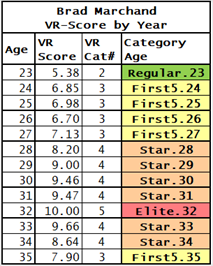
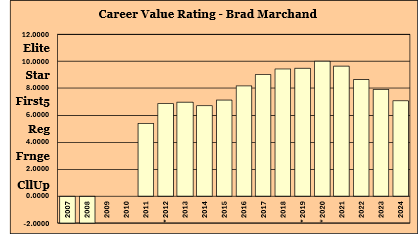
To explain the colours used to shade the cells in the Category Age column, I like to use the colours of the rainbow to represent Categories whenever I can: red, orange, yellow, green, blue, indigo and violet. I use purple instead of indigo for CallUps as I cannot tell the difference between the two colours, and don’t need violet because there are only six categories. For a “did not play” or “did not qualify” situation, I will use grey or black, depending on the background of the chart/table.
Marchand started playing in 2009 (the year is not in a yellow box, meaning he played at least one game that season), and in 2011 he had finally played enough games to qualify for a Value Rating. His VR-Chart is stereotypical: he improved as he gained experience, he hit a career peak, and then he started an age-related decline.
Marchand contributed data to four VR-Categories and to thirteen Category-Age groups.
At age 32, Marchand was a VR-Elite. His subsequent VR-Score was 9.66, so his contribution to the Elite.32 group was 9.66 PR-Points. He was then in the Star.33 group and his contribution to it was 8.64 PR-Points.
Age-to-Age Changes in Level of Play
The following chart shows age-to-age changes in players, grouped by the VR-Category they were in at the start of the season.
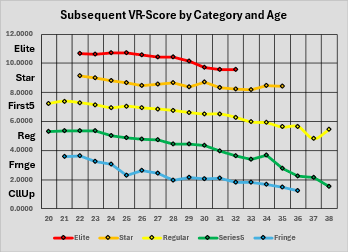
VR-Scores are defined on the vertical axis on the left of the chart, as are the VR-Category names. Age is defined on the horizontal axis at the bottom of the chart. A particular point on a line represents the average VR-Score in the subsequent season of all players who were in the category at the end of the previous season. For example, Regular 28 (green line in the column “28”) had a subsequent VR-Score of 4.43, while Regular 34 had a subsequent VR-Score of 3.67.
All categories see a decline as age increases. VR-Regular seems to be the group most beset by age-related decline, especially after age 34. VR-Star looks to be the group that ages best, but they stay below VR-Elite level. Conversely, VR-Elite players might decline a little more, but they are still significantly better than a similarly aged VR-Star player.
There is no age at which a lower-rated player has a better future than a higher-rated player: the chart lines do not cross. This is, of course, what we would expect.
To stress a comment I made earlier that could have been missed, players who did not qualify for VR-Score in a subsequent season, whether due to injuries or retirement, were treated as having a subsequent VR-Score of 0.00. The biggest reason that VR-Star and VR-Elite players don’t suffer huge age-related changes is that they tend not to retire while playing at that level, so they rarely get future VR-Scores of 0.00.
Career Peaks
VR-Elite players maintain their peak level of play through at least age 32. They aren’t dropping much in terms of percentage of VR-Score; the size of the drop on the chart is related to the drop being a small percent of a big number. For an obscure elaboration, a millionaire who loses 10% of $8,000,000 loses more money than another millionaire who loses 5% of $6,000,000, but the former is still wealthier than the latter.
VR-Star players maintain their level of play through age 31, and their decline afterwards is very gentle.
VR-First5 players also maintain their level of play through age 31, but their decline afterwards is more precipitous.
VR-Regular players maintain their level of play through age 27 and decline rapidly afterwards.
VR-Fringe players maintain their peak level of play through age 24 and decline rapidly afterwards.
Summary
This article used a different evaluation approach from the earlier Career Peak article, but its results are very similar. Better players, as a group, retain their peak value longer and age more gently than regular players.
It is, of course, impossible to accurately predict the future of any one player, even for just one year. The data shown in this article is merely an indication of what might happen. Other indicators will be the player’s health and the player’s recent history. Has he been stable recently, or has he been declining? Will his team be stronger next season? Is he likely to change roles next season? As Shakespeare has Hamlet say, “There are more things in heaven and earth, Horatio, than are dreamt of in your philosophy.”
Related Articles
Introduction to Value Rating
Productivity Rating Method 2
Career Peak
